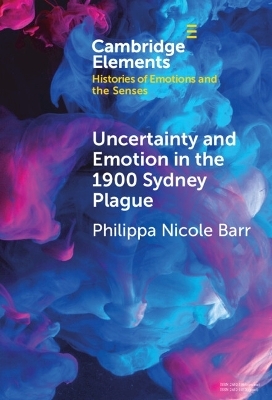
Uncertainty and Emotion in the 1900 Sydney Plague
Seiten
2024
Cambridge University Press (Verlag)
978-1-009-46210-5 (ISBN)
Cambridge University Press (Verlag)
978-1-009-46210-5 (ISBN)
This Element demonstrates that during the 3rd global plague pandemic, disgust was a means of producing and protecting social identity rather than a form of pathogen avoidance. By presenting flexibility in the disgust response, it contributes to debates about the influence of knowledge on embodied emotion and affect.
When the third global plague pandemic reached Sydney in 1900, theories regarding the ecology and biology of disease transmission were transforming. Changing understandings led to conflicts over the appropriate response. Medical and government authorities employed symbols like dirt to address gaps in knowledge. They used these symbols strategically to compel emotional responses and to advocate for specific political and social interventions, authorising institutional actions to shape social identity and the city in preparation for Australia's 1901 Federation. Through theoretical and historical analysis, this Element argues that disgust and aversion were effectively mobilised to legitimise these actions. As an intervention in contemporary debates about the impact of knowledge on emotion and affect, it presents a case for the plasticity of emotions like disgust, and for how both emotion and affect can change with new medical information.
When the third global plague pandemic reached Sydney in 1900, theories regarding the ecology and biology of disease transmission were transforming. Changing understandings led to conflicts over the appropriate response. Medical and government authorities employed symbols like dirt to address gaps in knowledge. They used these symbols strategically to compel emotional responses and to advocate for specific political and social interventions, authorising institutional actions to shape social identity and the city in preparation for Australia's 1901 Federation. Through theoretical and historical analysis, this Element argues that disgust and aversion were effectively mobilised to legitimise these actions. As an intervention in contemporary debates about the impact of knowledge on emotion and affect, it presents a case for the plasticity of emotions like disgust, and for how both emotion and affect can change with new medical information.
1. Introduction; 2. Outbreak of plague at Sydney, 1900; 3. The symbolism of dirt in discursive responses to plague; 4. Development of a city; 5. 'A maze of contradictory observations': medical eclecticism and changing understandings of disease causation; 6. Transforming the atmosphere; 7. Mediating affect; Bibliography.
| Erscheinungsdatum | 02.02.2024 |
|---|---|
| Reihe/Serie | Elements in Histories of Emotions and the Senses |
| Zusatzinfo | Worked examples or Exercises |
| Verlagsort | Cambridge |
| Sprache | englisch |
| Themenwelt | Geschichte ► Teilgebiete der Geschichte ► Kulturgeschichte |
| Studium ► Querschnittsbereiche ► Infektiologie / Immunologie | |
| Sozialwissenschaften ► Soziologie | |
| ISBN-10 | 1-009-46210-5 / 1009462105 |
| ISBN-13 | 978-1-009-46210-5 / 9781009462105 |
| Zustand | Neuware |
| Informationen gemäß Produktsicherheitsverordnung (GPSR) | |
| Haben Sie eine Frage zum Produkt? |
Mehr entdecken
aus dem Bereich
aus dem Bereich
der stille Abschied vom bäuerlichen Leben in Deutschland
Buch | Hardcover (2023)
C.H.Beck (Verlag)
CHF 32,15
Die Revolution des Gemeinen Mannes
Buch | Softcover (2024)
C.H.Beck (Verlag)
CHF 16,80


